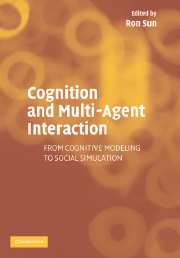Book contents
- Frontmatter
- Contents
- List of Contributors
- Preface
- PART 1 INTRODUCTION
- PART 2 OVERVIEWS OF COGNITIVE ARCHITECTURES
- PART 3 MODELING AND SIMULATING COGNITIVE AND SOCIAL PROCESSES
- 5 Cognitive Architectures, Game Playing, And Human Evolution
- 6 Simulating A Simple Case Of Organizational Decision Making
- 7 Cognitive Modeling of Social Behaviors
- 8 Cognitive Agents Interacting in Real and Virtual Worlds
- 9 Modeling Social Emotions and Social Attributions
- 10 Communicating and Collaborating with Robotic Agents
- 11 Behavior-Based Methods for Modeling and Structuring Control of Social Robots
- 12 Evolution of a Teamwork Model
- 13 Sociality in Embodied Neural Agents
- 14 Cognitive Architecture and Contents for Social Structures and Interactions
- PART 4 A SYMPOSIUM
- Index
12 - Evolution of a Teamwork Model
Published online by Cambridge University Press: 15 December 2009
- Frontmatter
- Contents
- List of Contributors
- Preface
- PART 1 INTRODUCTION
- PART 2 OVERVIEWS OF COGNITIVE ARCHITECTURES
- PART 3 MODELING AND SIMULATING COGNITIVE AND SOCIAL PROCESSES
- 5 Cognitive Architectures, Game Playing, And Human Evolution
- 6 Simulating A Simple Case Of Organizational Decision Making
- 7 Cognitive Modeling of Social Behaviors
- 8 Cognitive Agents Interacting in Real and Virtual Worlds
- 9 Modeling Social Emotions and Social Attributions
- 10 Communicating and Collaborating with Robotic Agents
- 11 Behavior-Based Methods for Modeling and Structuring Control of Social Robots
- 12 Evolution of a Teamwork Model
- 13 Sociality in Embodied Neural Agents
- 14 Cognitive Architecture and Contents for Social Structures and Interactions
- PART 4 A SYMPOSIUM
- Index
Summary
INTRODUCTION
For heterogeneous agents working together to achieve complex goals, teamwork (Jennings, 1995; Yen, Yin, Ioerger, Miller, Xu, & Volz, 2001; Tambe, 1997a) has emerged as the dominant coordination paradigm. For domains as diverse as rescue response, military, space, sports, and collaboration between human workmates, flexible, dynamic coordination between cooperative agents needs to be achieved despite complex, uncertain, and hostile environments. There is now emerging consensus in the multiagent arena that for flexible teamwork among agents, each team member is provided with an explicit model of teamwork, which entails commitments and responsibilities as a team member. This explicit modeling allows the coordination to be robust, despite individual failures and unpredictably changing environments.
Building on the well-developed theory of joint intentions (Cohen & Levesque, 1991) and shared plans (Grosz & Kraus, 1996), the STEAM teamwork model (Tambe, 1997a) was operationalized as a set of domain independent rules that describe how teams should work together. This domain-independent teamwork model has been successfully applied to a variety of domains. From combat air missions (Hill, Chen, Gratch, Rosenbloom, & Tambe, 1997) to robot soccer (Kitano, Asada, Kuniyoshi, Noda, Osawa, & Matsubara, 1997) to teams supporting human organizations (Pynadath & Tambe, 2003) to rescue response (Scerri, Pynadath, Johnson, P., Schurr, Si, & Tambe, 2003), applying the same set of STEAM rules has resulted in successful coordination between heterogeneous agents. The successful use of the same teamwork model in a wide variety of diverse domains provides compelling evidence that it is the principles of teamwork, rather than exploitation of specific domain phenomena, that underlie the success of teamwork-based approaches.
- Type
- Chapter
- Information
- Cognition and Multi-Agent InteractionFrom Cognitive Modeling to Social Simulation, pp. 307 - 327Publisher: Cambridge University PressPrint publication year: 2005
- 11
- Cited by

